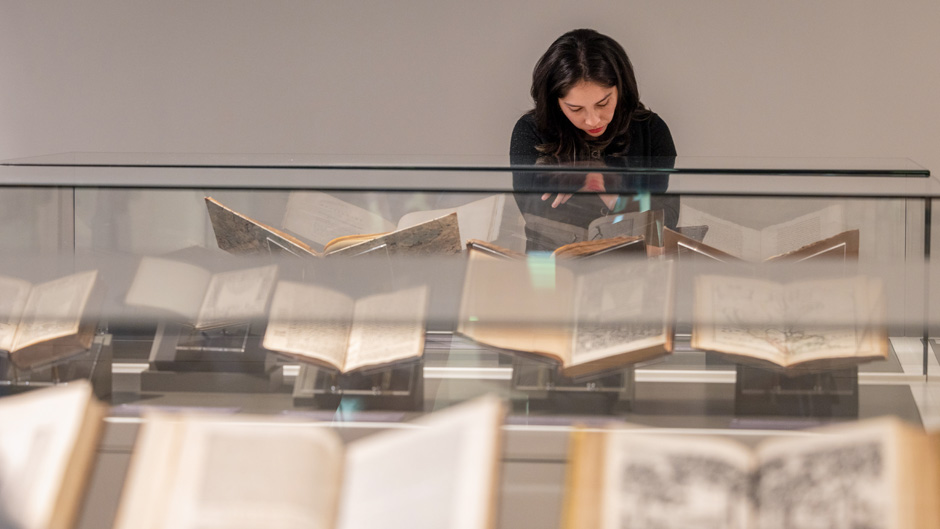For Susanna Allés Torrent, it was a rare find.
A 1691 book written by Abraham ben Mordecai Farissol in Hebrew with a Latin translation, which detailed Christopher Columbus’ discoveries in the Americas.
An associate professor who teaches medieval and early modern literature at the University of Miami College of Arts and Sciences’ Michele Bowman Underwood Department of Modern Languages and Literatures, Allés Torrent thought it would be perfect for one of her classes.
“I am very interested in what they have,” she said while touring the Jay I. Kislak Collection of the Early Americas, Exploration and Navigation at the University of Miami Libraries. “I am looking for primary sources.”
Allés Torrent and a group of other professors, graduate students, and staff members took part in the tour after being part of the midday workshop “First-Hand Knowledge: Exploring Primary Sources at UM Libraries,” where several library leaders spoke about the collections at the University.
The seminar offered students and faculty and staff members an introduction to the rich and varied repository of primary sources that are available through the Cuban Heritage Collection (CHC), the Special Collections, the Kislak Collection, and University Archives.
Nick Iwanicki, University archivist, spoke about the meaning of primary sources. These are firsthand accounts, which can be derived from original documents, newspapers, photographs, videos, maps, and audio files. He pointed out that it was important for students to interact with primary sources.
“These encourage critical thinking because you can study what people thought at the time and what people’s goals were by creating them,” he said.
Iwanicki also showcased all the areas under University Archives, which hold information about the University since its beginning. These include the book “The University of Miami: A golden anniversary history, 1926-1976,” written by Charlton W. Tebeau about the first 50 years of the University. It is now digitized and can be accessed through the Libraries Digital Collections.
The archivist mentioned the Taylor Family/UTrailblazers Experience interactive exhibit, which highlights the achievements of the first Black graduates of the University and is on display at the Dooly Memorial Classroom Building breezeway. An accompanying book, “Our Legacy Matters,” also can be obtained digitally.
Amanda T. Moreno, interim Esperanza Bravo de Varona chair of the CHC, gave an overview of the collection, the largest repository of materials about Cuba outside the island. It possesses close to 75,000 published items and more than 800 archival collections, she noted.
Any scholar researching the history of the island and its diaspora would benefit from the numerous collections, which range from literary and political papers to an assortment of ephemera that documents the experiences of the global Cuban community, according to Moreno. Tours of the facility and access to the materials are available by making an appointment.
“The materials found at CHC tell stories about individuals and institutions that are important to the cultural memory formation of the Cuban diaspora,” Moreno said. Besides archives, the CHC hosts a graduate fellowship program and a biennial conference on Cuban studies, supported by The Goizueta Foundation, and sponsors other events related to Cuba and its diaspora.
Cristina Favretto, head of Special Collections, said the reserve gives students an opportunity to engage in a very personal and meaningful way with primary source documents.
“I always tell students that when they visit a museum they cannot touch the paintings,” she said. “Well, in Special Collections you can actually turn the pages of a book from the Renaissance, read it, and experience it as someone would have 500 years ago.”
Among the most popular collections are:
- The Pan Am Airways Collection, which includes printed and digitized images of annual reports, brochures, directories, periodicals, and timetables of the iconic airline, as well as promotional and operational records from the 1920s through 1991.
- The Jackie Gleason Collection, approximately 1,700 volumes of books, journals, and pamphlets in the field of parapsychology.
- Zines Collection. The University has more than 15,000 Zines or fanzines, which are small-batch, independently published works that in many cases focused on social and political activism.
- Artists’ books, where the book is essentially a piece of art, sometimes unique. Special Collections has more than 2,500 of these beautiful items.
Other collections include rare books, archival collections, and ephemera that documents the history of South Florida, Latin America, and the Caribbean.
Arthur Dunkelman, director and curator of the Kislak Collection, who oversees the collection that contains some of the most important original source materials related to the history of the early Americas, talked about the importance of approaching archival material by creating “an intellectual map.”
As you approach a book or a document, “you must examine it physically and get a feel for it,” he said. “You need to ask the why, what, where, when, and how.” When answering those questions, the documents will speak to you, he said.
Paul Clough, digital architect and infrastructure librarian, spoke about the many digital collections offered through the libraries’ website. And he offered an easy way to search them.
Rita Johnston, head of digital initiatives, walked the participants through the importance of knowing whether the books and documents to be used were in the public domain or if they had copyright restrictions.
Visit www.library.miami.edu to learn more about the University Libraries and its vast holdings.

